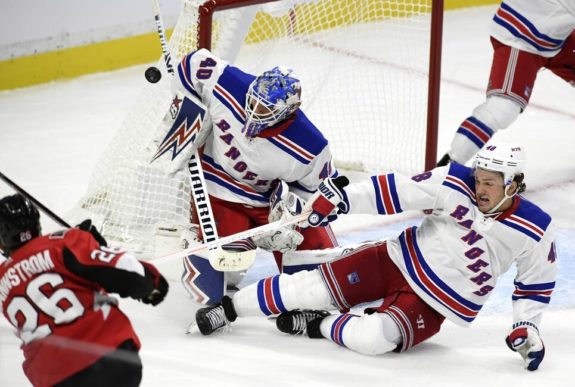The New York Rangers remained idle last week during a six-day break between a win on the road, against the Ottawa Senators on Oct. 5, and a loss, at home, to the Edmonton Oilers on Oct. 12. The Blueshirts opened the 2019-20 season with a win over the Winnipeg Jets and currently sit at the tail end of another four-day break. Everything sounds great, except for the “sitting” part.
Momentum, Rhythm, & Consistency
A six-day scheduled break, followed by a game, and then another four-day break could produce both useful and harmful results for the team. Let’s start with the cons of these odd pauses. A sudden halt to the momentum generated from playing good hockey, especially so early into a season, is never a good thing.
On their return, the Rangers looked great in the first two periods, but ultimately lost to a hot Oilers team who found a way to win in the third. Momentum played a key role, as the Oilers started the season with five straight wins. Since the start of the season, the Blueshirts have only played three games, the least of any team in the NHL.

Players want to keep the train rolling when everything is clicking and the team is winning. Something I feared was a structural breakdown following their return on Oct. 12, which seemed to happen in the third period against Edmonton. These two schedule breaks remind me of a similar situation of when a team enters a bye week, with a full head of steam and returns to find that fire has been extinguished. (from ‘Bye weeks proving to be disastrous for NHL teams,’ Chicago Tribune, 02/21/2017) Being out of rhythm for, even a short time, can mess with the psyche that develops from consistent play, which keeps the mind sharp.
Game Intensity
What makes or breaks a team’s return after a long stretch of downtime is a simple variable: intensity. Sure, in this case, the Rangers were still at the rink for practice, reviewed film, did workouts and put in valuable work every day, but nothing compares to the intensity of a game. It is difficult to simulate game speed and harsh, physical play with your teammates. Maintaining game intensity requires a consistent schedule. Look at the 2019 playoffs, especially in the East.

Team A would sweep their opponent, have an abundance of time in-between series, lose their intensity, and then get swept by Team B that battled through a grueling seven-game series and never lost the playoff routine. Success boils down to consistent game intensity.
An Opportunity to Regroup and Return Stronger
Now, let’s shift to the positive side of the two breaks. The start of a season can be stressful, especially for a number of rookies trying to learn the inner-workings of an NHL schedule. The emotional build-up leading to a game can drain a person’s energy, both physically and mentally. Right away, they experienced both a home and away game. They’ve undergone the commotion from a home crowd, the travel that comes with a road game and how brutal other teams’ fans can be. Then, they went into the first break.
During that break, the entire organization was given a chance to take a quick breath and regroup. They had six-days of practice to review mistakes made from the first two games to clear any confusion that may come from offseason rust or what they may have missed during training camp. The third game against Edmonton was an opportunity for the coaching staff and players to take what they learned in practice and execute it the right way, to fix those issues during the game. This is great for progress, even if the end result was a loss. Besides, a few more conditioning workouts early in the season never hurt anyone.
In the video below, Mika Zibanejad, who leads the Rangers with eight points, displays his obvious disapproval with the first break. Being professional, however, he transitions the conversation to how the team will continue working in practice and must focus on looking forward.
Using the Break Effectively
Hopefully, head coach David Quinn pushed the message that these two breaks weren’t simply a vacation, but an opportunity to tighten the reins early and work on areas that need to be fixed. Luckily, the Rangers started hot, but I can guarantee Quinn scribbled a few notes over the first three games that he planned to address during the breaks. If this time was used effectively, they can build on the start of the season.
Fans, even players, may not have been enthusiastic about the schedule because they wanted to watch more games, but if the team grew closer during the break and can win more games because of it, I believe more may accept these breaks early on. If the Rangers continue to grapple with a few losses following this four-day break, we may have a meltdown from the fanbase.
Ultimately, the Rangers know they need to come out fast and hard against New Jersey on Thursday and continue to play good hockey over the next games, pretending as if the scheduled breaks never even phased them. If the coaching staff and players were productive with their time, we may see this team climb the standings early in the season.